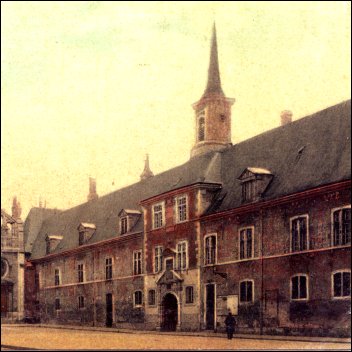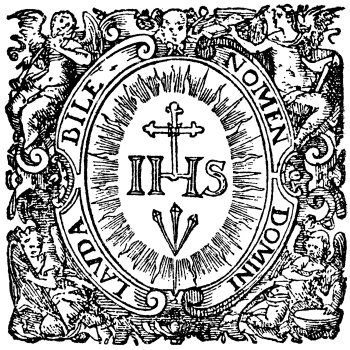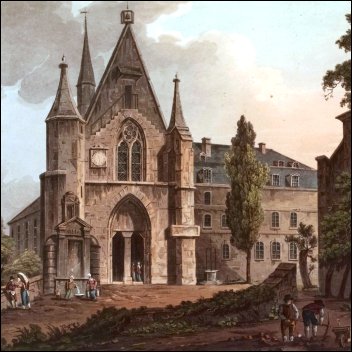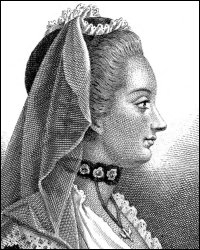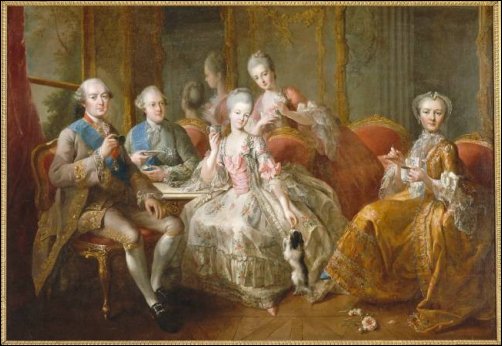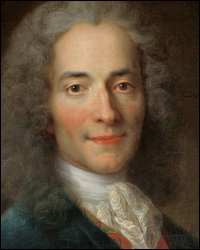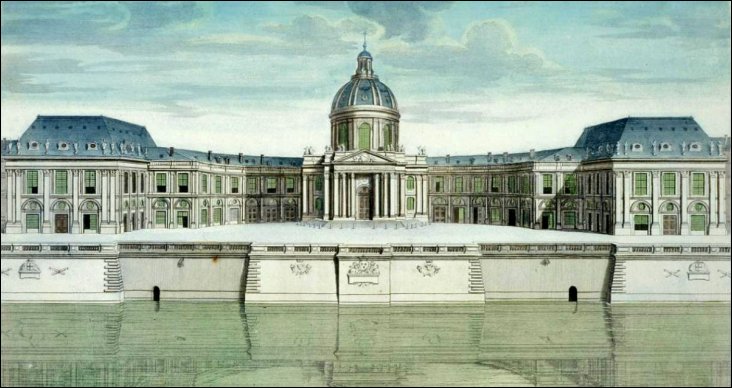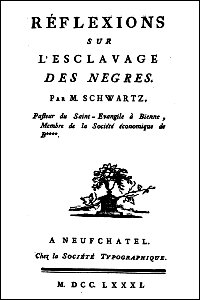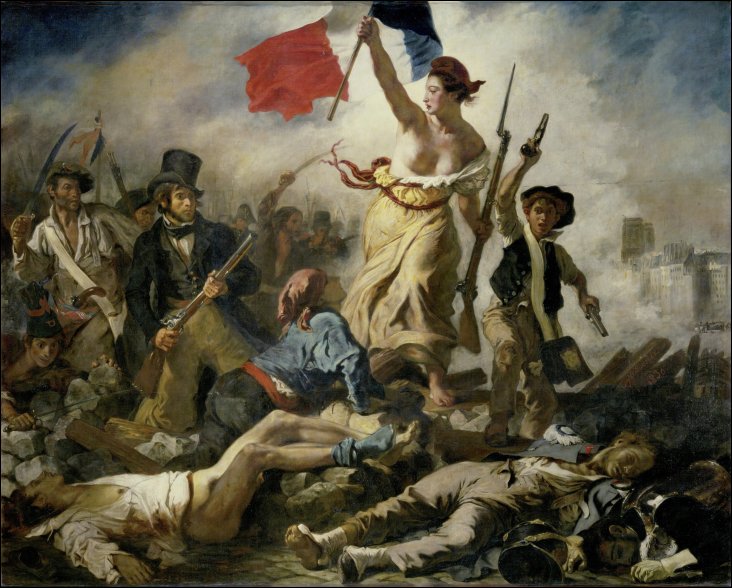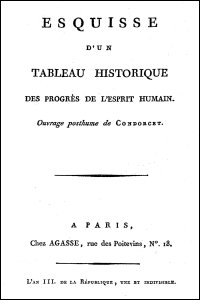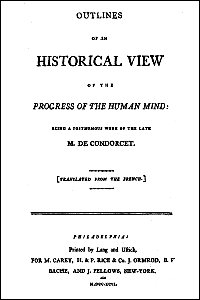Condorcet
![]()
CONDORCET, marquis de
[ Marie-Jean-Antoine-Nocolas de CARITAT ]
—
(Ribemont, 17 September 1743 – Bourg-la-Reine, 28 Mars 1794)
—
French aristocrat, descendant from an old family referred to a town in Dauphiné.
—
Humanist, rationalist, and progressist philosopher of the Enlightenment.
—
Mathematician, geometer, pedagogue, economist and engineer.
—
Social theorist, political ideologist (republican), human rights activist, feminist, and abolitionist promoter, editor and publicist.
—
Statesman and revolutionary.
—
![]() —
—
—
PORTRAITS |
||
|
|
|
|
![]()
—
BIOGRAPHIC CHRONOLOGY
—
| 1743 − | Birth (September, 16) in Ribemont, Picardie, France, son of Jean-Pierre-Antoine Caritat (marquis) de Condorcet (1702-1743), a military, captain of the Barbançon regiment, and of Marie Madeleine Catherine Gaudry (1710-1784). |
| 1743-1754 − | Having become a father orphan five weeks after birth – his father was killed (October 22, 1743) on manoeuvres near Neuf Brisach, France –, Condorcet spent the youth with his mother, in Ribemont, treated in an extremely protective manner, dressed as a baby girl (in white dresses) until he was eight, kept away from other children, and prevented from the open-air play young boys normally enjoy. |
| 1551-1754 – | Condorcet’s uncle, Jacques-Marie de Caritat de Condorcet (1793-1783) ⊕, bishop of Auxerre at the time, concerned with the proper education of the nephew, arranged for a Jesuit tutor to teach him at home from the age of nine to eleven. |
—
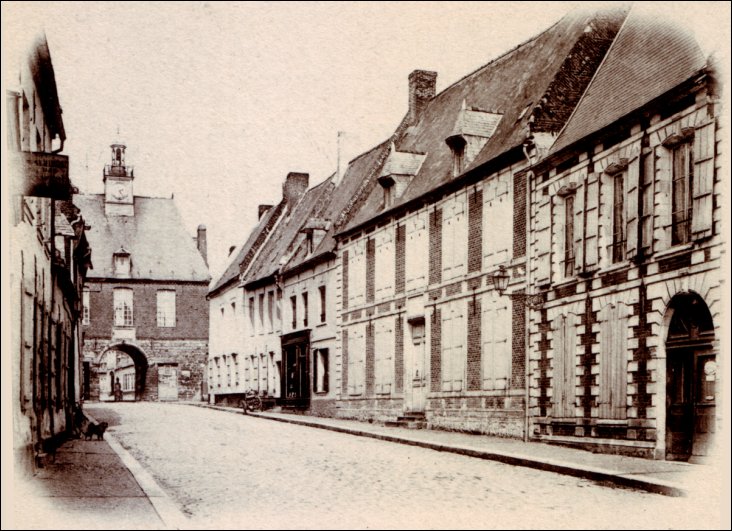 |
—
—
| 1754-1757 − | From eleven to fifteen years old, allways under the ascendancy of his uncle, Condorcet made formal primary studies at Jesuit College, in Reims. |
| 1758-1760 − | Still following his uncle’s influence, Condorcet developed studies at the ‘Collège de Navarre’ [Navarre’s College] ⊕, in Paris, where he frequented experimental physics instruction – taught in French, not in Latin – from Jean-Antoine Nollet (1700-1770), and got mathematic and philosophic teaching from Mathurin-Georges Girault de Kéroudou (1730-1786), from whom he also gained a passionate interest for both subjects. |
| While he was still in Navarre’s College, Condorcet wrote an ‘ESSAI SUR LE CALCUL INTÉGRAL’ [Essay on Integral Calculation], a thesis later (1769) read in the ‘Académie Royale des Sciences’ [Royal Academy of Sciences] before Jean-Baptiste le Rond, dit d’Alembert ⊕, Alexis Claude Clairaut (1713-1765) ⊕ and Alexis Fontaine des Brtins (1704-1771) ⊕. |
—
|
|
|
|
|
—
| 1760-1762 − | Determined to pursue a life in mathematics study and science research despite family opposition – such a career was considered a deviation from the hereditary spirit of a noble standing –, Condorcet spent two years at home, in Ribemont, studying on his own, arguing to be allowed to achieve his will. |
| 1761 – | Condorcet presents to the ‘Académie Royale des Sciences’ the thesis ‘ESSAI D’UNE MÉTHODE GÉNÉRALE POUR INÉGRER LES ÉQUATIONS DIFFÉRENTIELLES À DEUX VARIABLES’ [Essay of a Method for Integrating Two-Variable Differential Equations]. |
| 1762 – | Condorcet leaves Ribemont and goes to Paris where he started living in rue Jacob, close to the University, in a small attic above the home of Kéroudou, his former teacher. |
| 1763 – | Condorcet enters in contact with the Italian-French mathematician and astronomer Joseph-Louis Lagrange (1736 – 1813) ⊕, born Giuseppe Lodovico Lagrangia. |
| Condorcet becomes close to d’Alembert. | |
| 1765-68 – | Condorcet publishes ‘DU CALCUL INTEGRAL’ [On Integral Calculation] (1765), ‘DU PROBLEME DES TROIS CORPS’ [On Problem of the Three Bodies] (1767) and ‘ESSAIS D’ANALYSE’ [Essay on Analysis] (1768), three important research works on mathematics. |
| 1769 – | As a result of those relevant memoirs, Condorcet is elected to the ‘Académie Royale des Sciences’ as ‘adjoint mécanicien’. |
| D’Alembert introduces Condorcet into the aristocratic ‘salon’ then opened by Jeanne-Julie-Éléonore de Lespinasse (1732-1776) ⊕ rue de Belle Chasse, where he became acquainted with Anne-Robert-Jacques Turgot (1727-1781) ⊕, among other notables. | |
| Condorcet is received as a member by the Science Academies of Berlin, Turin, Bologna, St. Petersburg and Philadelphia. |
—
—
| 1770 – | Condorcet is promoted to ‘associé mécanicien’ at the ‘Académie Royale des Sciences’. |
| 1772 – | Condorcet accepts the invitation to collaborate in the ‘NOUVEAU DICTIONNAIRE POUR SERVIR DE SUPPLÉMENT AUX DICTIONNAIRES DES SCIENCES, DES ARTS ET DES MÉTIERS’ [New Dictionary to serve as Supplement to the Dicctionaries of Sciences, Arts and Crafts] (1776-1777). |
| 1773 – | Condorcet and d’Alembert spent two weeks (from September 23 to October 9) with François-Marie Arouet, best known as Voltaire (1694-1778) ⊕, in his palace at Ferney. |
—
—
| 1773 − | Condorcet publishes ‘ÉLOGES DES ACADÉMICIENS DE L’ACADÉMIE ROYALE DES SCIENCES, MORTS DEPUIS L’AN 1666 JUSQU’EN 1699’ [Praise the Academitians of the Royal Academy of Sciences, who died from the year 1666 until 1699]. |
| Condorcet is elected ‘pensionnaire surnuméraire, adjoint avec survivance au Sécrétaire perpectuel’ [supernumerary resident, surviving assistant to the Perpectual Secretary] of the ‘Académie des Sciences’. | |
| 1774 – | Condorcet writes an ’ALMANACH ANTI-SUPERSTITIEUX’ [Anti-Superstitious Almanac]. |
| Condorcet presents a memoir about the comets to the Berlin Science Academy. | |
| Condorcet publishes ‘LETTRES SUR LE COMMERCE DES GRAINS’ [Letters on Grain Trade]. | |
| Condorcet publishes ‘LETTRES D’UN THÉOLOGIEN À L’AUTEUR DU DICIONNAIRE DES TROIS SIÈCLES’ ⊕ [Letters from a theologian to the author of the Diccionary of Three Centuries] defending the philosophes against the acusetions made by the abbée Antoine Sabatier de Castres (1742-1817) ⊕. | |
| 1775 – | Condorcet is nominated ‘Inspecteur Général de la Monnaie’ [General Inspector of the Mint] by Turgot, then Minister of Finances (1774-1776) of king Louis XVI. |
| Condorcet writes a letter to Voltaire demonstrating the necessity of defending atheist philosophers like d’Alembert and Paul-Henri Thiry (Paul Heinrich Dietrich), baron d’Holbach (1723-1789) ⊕. | |
| Condorcet publishes a series of brochures defending Turgot’s economic reforms, notably ‘LETTRE D’UN LABOUREUR DE PICARDIE À M. N.***’ [Letter from a ploughman from Picardy to Mr. N.*** – Jacques Necker (1732-1804) ⊕], ‘RÉFLEXIONS SUR LES CORVÉS’ [Thoughs about the Chores], ‘MONOPOLE ET MONOPOLEUR’ [Monopoly and Monopolist], ‘RÉFLEXIONS SUR LA JURISPRUDENCE UNIVERSELLE’ [Thoughs about Universal Jurisprudence] and ‘RAPPORT SUR UN PROJET DE RÉFORMATEUR DU CADASTRE’ [Report on a Land Register Reform Project]. |
|
| 1776 – | Being ‘Inspecteur Général de la Monnaie’, Condorcet settles in his official accommodation of the ‘Hôtel des Monnaies’ where he brings his mother and his uncle Gaudry. The family house of Ribemont is sold. |
| Condorcet publishes ‘FRAGMENT SUR LA LIBERTÉ DE PRESSE’ [Fragment on Freedom of the Press]. |
—
| 1776-1777 – | Condorcet publishes 25 mathematical articles in the ‘NOUVEAU DICTIONNAIRE POUR SERVIR DE SUPPLÉMENT AUX DICTIONNAIRES DES SCIENCES, DES ARTS ET DES MÉTIERS’ [New Dictionary to serve as Supplement to the Dicctionaries of Sciences, Arts and Crafts]. |
—
mnmnmnmnm
—
![]()
—
A broadcast short note on Condorcet in The Engines of Our Ingenuity, a daily radio series produced jointly by KUHF-FM, Houston, Texas, and the University of Houston.
—
—
![]()
—
![]()
—
—
ACADEMIC ACTIVITY (some books)
—
In 1773, Condorcet became Deputy Secretary to the French Académie Royale des Sciences [Royal Academy of Sciences] and, from 1777 to 1793, its Permanent Secretary; in 1782, he also became a Permanent Secretary to the Académie Française [French Academy].
—
—
——
![]()
ECONOMIC-POLITICAL ACTIVITY (some books)
—
- As an economist, Condorcet worked closely with Anne Robert Jacques Turgot, fiances minister under king Louis XVI’s, and has been nominated Inspecteur Général de la Monaie [General Inspector of the Mint], a place he kept from 17… to 17…;
——
SOCIAL-POLITICAL ACTIVITY (some books)
—
Engaged in social/political causes from an early age, namely standing up for slave abolitionism, gender equality, Jewish freedom, religious tolerance and economic liberty.
—
—
[slideshare id=98431193&doc=condorcetmethod-180524093638&type=d]
—
Condorcet has been co-founder (1788, February, 19), with Jacques Pierre Brissot, of the Société des amis des Noirs [Society of the Friends of the Blacks]; and, during the Revolution, he has been an active member of the political club Cercle social [Social Circle] and Les Amis de la Vérité [Friends of truth]. He has also been the first politician to justify and promote a republican solution for France after king Louis XVI attempted to join Austrian armies invading the country to fight the revolutionary process going on.
—
| — |
 (1789) |
| ⊕ |
—
—
—
![]()
—
Closely related to Thomas Paine (1737-1809), Thomas Jefferson (1743-1826) and Benjamin Franklin (1706-1790), Condorcet has been an active French supporter of the independence of the New World (North American) colonies.
—
| a |
—
FRENCH REVOLUTION
—
—
 |
| (1753-1793) et (1762-1790) [the great ones seem great to us only because we are on our knees. Let’s stand up] motto of the newspaper «Les Révolutions de Paris» paraphrasing Étienne de la Boétie (1530-1563) “les tyrans ne sont grands queue parce que nous sommes à genoux” |
—
After 1789, Condorcet went very actively involved in the French Revolution, most specifically engaged on:
- designing an educational reform through a universal, unpaid and secular Public School («École Publique»);
- promoting a Déclaration des Droits de l’Homme et du Citoyen [Declaration of Rights of Man and Citizen], in 1789;
- standing for the equality among men and women;
- fighting for the abolition of slavery;
- encouraging a republican solution for France after king Louis XVI’s counterrevolutionary conspiracy with Austria and other foreign nations, in August of 1792.
—
 (1788) |
e |
—
![]()
—
Condorcet stands as one of the former and major formulators of the Idea of Progress, advocating the possibility of indefinite perfectibility for Humankind funded on republican, democratic and secular (laicist) political practices, strongly supported on a significant increase of people’s wisdom based on a generalisation of knowledge promoted by a public system of civil (civic) education.
![]()
Esquisse d’un Tableau Historique des Progrès de l’Esprit Humain (1794)
![]()
[ Sketch/Outlines of an Historical Picture of the Progress of the Human Mind ]
—
| ⊕ |
—
Condorcet’s Outlines/Sketch for a Historical Picture of the Progress of the Human Mind/Spirit (1794) [Esquisse d’un Tableau Historique des Progrès de l’Esprit Humain (1794)] is one of the clearest and perennial – long lasting and influential – formulations of the Idea of Progress ever written, making it a central concern of (Radical/Progressist) Enlightenment thought.
![]()
“[Condorcet] argued that expanding knowledge in the natural and social sciences would lead to an ever more just world of individual freedom, material affluence, and moral compassion. He argued for three general propositions: that the past revealed an order that could be understood in terms of the progressive development of human capabilities, showing that humanity’s “present state, and those through which it has passed, are a necessary constitution of the moral composition of humankind”; that the progress of the natural sciences must be followed by progress in the moral and political sciences “no less certain, no less secure from political revolutions”; that social evils are the result of ignorance and error rather than an inevitable consequence of human nature.”
[from Wikipedia]![]()
![]()
Outlines of an Historical Picture of the Progress of the Human Mind
Progress of the Human Mind – the tenth stage
The future progress of the human mind
Our hopes for the future condition of the human race can be subsumed under three important heads: the abolition of inequality between nations, the progress of equality within each nation, and the true perfection of mankind. Will all nationals one day attain that state of civilization which the most enlightened, the freest and the least burdened by prejudices, such as the French and the Anglo-Americans, have attained already? Will the vast gulf that separates these peoples from the slavery of nations under the rule of monarchs, from the barbarism of African tribes, from the ignorance of savages, little by little disappear?
The time will therefore come when the sun will shine only on free men who know no other master but their reason; when tyrants and slaves, priests and their stupid or hypocritical instruments will exist only in work of history and on the stage; and when we shall think of them only to pity their victims and their dupes; to maintain ourselves in a state of vigilance by thinking on their excesses; and to learn how to recognize and so to destroy, by force of reason, the first seeds of tyranny and superstition, should they every dare to reappear amongst us.
![]()
.
![]()
REFERENCES:
![]()
 |
 |
 |
 |
![]()
![]()
| François ARAGO – CONDORCET; A BIOGRAPHY (1841/1878)
in: Annual Report of the Board of Regents of the Smithonian Institution fom 1978. Washington, Government Printing Office, 1879 |
 |
| Alexandre KOYRÉ – CONDORCET (1948)
in: Journal of the History of Ideas, Vol. 9, No. 2 (April, 1948), pp. 131-152 – University of Pennsylvania Press |
 |
—
![]()
—

—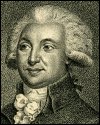
Les droits des hommes résultent uniquement de ce qu′ils sont des êtres sensibles susceptibles d′acquérir des idées morales et de raisonner sur ces idées. Ainsi les femmes, ayant ces mêmes qualités, ont nécessairement des droits égaux. Ou aucun individu de l′espèce humaine n′a de véritables droits ou tous ont les mêmes.
—
Marie-Jean-Antoine-Nicolas de Caritat, marquis de Condorcet (1743-1794)
—
—
http://www.inventaire-condorcet.com/Instruments/Chronologie_Condorcet

